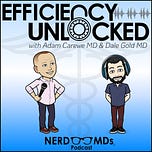Want to support Rewskidotcom Substack and the NerdMDs | Efficiency Unlocked Podcast?
♻️ Share this post with friends in healthcare
🫰 Become a paid subscriber
📢 Become a sponsor (email me)
🌟 Leave a 5-star review for the NerdMDs | Efficiency Unlocked Podcast
NerdMDs StackBytes
A rapid‑fire audio companion to NerdMDs Substack writing—each episode packs a recent essay, insight, or framework into a 10‑minute listen. Perfect for your coffee break or between meetings, StackBytes delivers:
Top takeaways from the latest Substack @ Rewskidotcom.substack.com
Actionable tips you can apply today in clinical practice, health tech, or productivity
Concise reflections that complement the written piece
When it drops: Between every main podcast interview, so you never miss a fresh StackByte. Tune in, think different—and stay efficient. Subscribing ensures you catch every byte, straight from the page to your ears.
🎧 StackByte Episode Summary
In this special StackByte session, our NotebookLM AI guest hosts walk through Dr. Adam Carewe’s Substack essay, “Why I Don’t Need Ambient AI Anymore”. They trace Adam’s journey from an early champion of ambient AI to a builder of something far more integrated: ambient cognition. Along the way, they explore why off-the-shelf AI tools often fail in messy healthcare realities, what makes vendor strategies fragile, and why the most powerful AI ends up being invisible—seamlessly woven into the way care is delivered.
🔹 00:00 – Intro & Setup
The NotebookLM hosts introduce the format: a 10-minute power dive into Adam’s latest Substack. They tease the arc from excitement about ambient AI to a deeper lesson about AI’s real future in medicine.
🔹 01:26 – The Promise of Ambient AI
The discussion begins with the allure of ambient AI tools like Abridge and Nabla, designed to automate note-taking so doctors can focus on patients. Clinicians felt relief, and patients noticed more present, human interactions.
“It targets that huge administrative burden… providers felt real relief, like they could actually be present again.”
🔹 03:58 – Where It Falls Short
Despite early success, the hosts explain why Adam concluded ambient AI wasn’t enough. Real medicine is nonlinear, collaborative, and spans years of context. Vendor tools, built around linear workflows, simply didn’t fit this reality—templates couldn’t solve the mismatch.
🔹 07:33 – Vendor Fragility & Epic’s Shadow
They examine the business dynamics: most startups just wrap foundation models and sell to big health systems. But brittle infrastructure, slow adoption cycles, and the risk of EHR giants like Epic offering native solutions make them fragile.
“When your entire business model is just a wrapper on someone else’s model… you’re one platform shift away from irrelevance.”
🔹 10:04 – Stop Waiting, Start Building
Adam’s team pivoted from waiting on vendors to building their own system. Unlike linear dictation models, it handled async + live loops, pulled context across years of patient history, synthesized info, and tailored outputs for team-based care.
🔹 12:22 – From Ambient AI to Ambient Cognition
Here the hosts spotlight Adam’s big conceptual leap: ambient cognition. Rather than just transcribing, AI became part of clinical thought, surfacing guidelines, history, and next steps in real time—enhancing judgment instead of merely documenting it.
🔹 12:46 – The Invisible AI Lesson
The key takeaway: the best AI doesn’t announce itself. It disappears into the workflow, showing up as clarity, speed, and confidence—like a great operating system you don’t notice, but can’t imagine working without.
🔹 14:20 – Wrap-Up & Challenge to Listeners
The hosts close by urging listeners to rethink their own work: instead of shopping for the perfect external tool, ask how to make workflows natively intelligent. The shift is from bolted-on tools to AI that feels like an extension of how we think and act.










